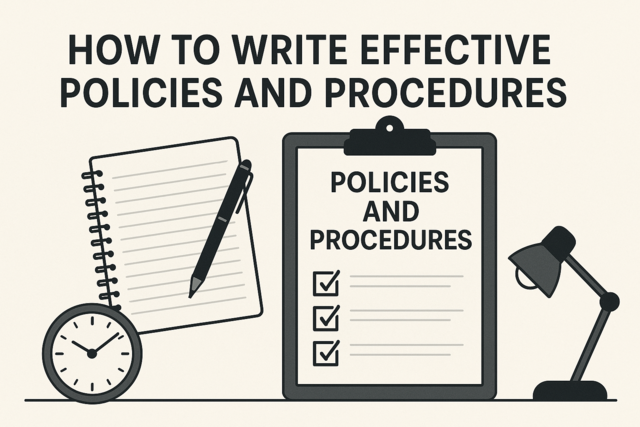Introduction:
This article will focus specifically on setting standards and expectations for excellent performance in the process of delegation. We will discuss the connection between the standards and expectations for the job that will result in excellent performance.
By the end of this article, the ability to develop, write, and communicate standards and expectations through goals and objectives should be very clear. Reference will be made to previous learning that has been covered in this class.
Setting standards and expectations for excellent performance in delegation means communicating clearly about the specific task being assigned, exactly what the result should accomplish, to what degree of accomplishment (the standard to which the employee will be held accountable), the expectation of each step, and how it will be monitored. By knowing the specific requirements of each task, the expectation at each step in the process, to what standard they will be held, and having a clear rubric for monitoring the objectives of each step, the employee will have no doubt about what the task embodies. Communication of the standards, goals, objectives, and resulting expectations is the key to success in each of these areas.
Focus Points:
1. The word standard has many meanings, but it has a specific meaning in the workplace.
In a company, organization, or office, the standards are the levels or degrees to which all are expected to strive. Those levels need not be stated numerically, but might. The standards must also be stated in active terms. For example, "The company will work to please the client 100 percent of the time." That's the standard to be reached. Will it happen 100 percent of the time? No, but the company cannot stop reaching. An excellent company, though striving for exactly that, should also look at their track record and establish a baseline for themselves. A baseline is the past pattern of accomplishment, and a baseline is necessary to set future goals.
A standard is often referred to as the "norm." However, what business wants to claim their standards are the "norm?" It isn't what you want. Standards should be set high and are sometimes unrealistic. It is the setting of the goals toward reaching that high standard that keeps an office moving in that direction. It projects the company toward excellence and keeps the challenge in place.
There are standards set up for an organization on which they continually focus. Beneath that umbrella are goals that should be set for a specific task. Under those goals are the objectives written to guide the steps toward meeting the goal. Standards are set first for a company; goals are set for each assignment that is delegated within the company, aligning with the company standards. Lastly, the objectives are written under each goal. The standard, goals, and objective must be stated in active terms and include some method of measurement by which anyone can ascertain that each has been accomplished. When all objectives are accomplished, the goal is accomplished. Hopefully the accomplishment of the goal supports the standards of the company.
Standards in the workplace may be used to inform employees about the expectation of the entire workplace. These standards are usually related directly to the work done there, but may also be directed to the personnel. For example, the standard for "dress," or the standard for working late. These kind of "standards" relate to personal goals. Each employee will be expected, in less formal ways, to demonstrate that they intentionally work to meet these personnel standards. It is hoped that an employee will show respect for the workplace by either meeting these standards, or working toward meeting them. For an employee to simply ignore these standards is a signal there are problems. It is management's job to keep everyone on their watch informed of, and focused on, the standards the company sets.
2. If goals are set with a direct connection to the company standards, the goals will be challenging, but realistic, and set up to reach levels that are a progression upward.
A manager is usually the person who is in charge of training. Immediately upon being hired, new employee should find themselves in a situation where a manager is explaining the standards of the company, how the company has worked toward these standards in the past, and what the expectation is for the future. This is not unimportant.
Every task that is delegated by a manager, requires the team to have an understanding, not only of the goals of this particular task, the objectives they will accomplish as they seek to meet each goal, but how what they do on a daily basis connects with the entire company, specifically in meeting the company standards.
Standards are set to publicly and internally hold the company work to be the best possible in its domain. Goals must connect with the standards. When a team is given an assignment to do work for a company client, the manager will have chosen the person or the team that is a good "fit" for this task. And there it all begins to play out. The work each individual does, the demonstration of reaching each milestone or objective stated under the goal, the completion of each goal to the highest expectation possible creates a company whose personnel work to meet the standards of the company.
A goal requires a completed part of the project or task to be stated less broad than the company standard and in active terms. For example, "The worker will develop a "cutting edge" table top model for a clubhouse that can safely hold 250 persons, includes each of the following: a basic style kitchen, two restrooms, storage for tables and chairs, be IDEA approved, and rated by peers on an informal and anonymous rating scale that is attached; receiving a rating of 3 out of 4 acceptable ratings, by March 25, 2015." What is not stated gives room to the creativity and skills of the worker in design, materials used, and style. This goal informs the result, that it will be measured by using a peer rating scale that determines three out of four anonymous peers finds it acceptable. The rating scale will be developed by the team or manager and attached as part of the assignment. Everyone should be open about what is acceptable, or not.
If your company standard is that, "Work at Our Company is cutting edge," then your workers will understand that your company was chosen to do the work because of their standard of being "cutting edge." If the worker uses a common design with outdated styles, then they are not paying attention to what their own company standards are. Part of the reason for the choice of company, the choice of the team, or person to work on the task is connected to the company standard of being "cutting edge." Everything in the organization must relate to the company standard. How that is interpreted and carried out is left to the imagination of the individuals and the manager of the task. It is in the objectives, under each goal, where the interpretation is planned.
3. Objectives are the steps on a timeline that keep the worker moving toward the goal in specific and measurable ways.
If your goal is, "The worker will develop a 'cutting edge' table top model for a clubhouse that can safely hold 250 persons, includes each of the following: a basic style kitchen, two restrooms, storage for tables and chairs and be IDEA approved, and rated by peers on an informal and anonymous rating scale that is attached, receiving a rating of 3 out of 4 acceptable ratings, by March 25, 2015," then the objectives will be listed under that goal, be more specific, and on a timeline as well. It is very important that the worker who is assigned this task, or the team who will carry out the work, acts to write each objective. At this point, the involvement of the manager may be as little as looking at them after they are written, or as great as guiding how they are stated. How much involvement the manager will have at this stage of delegation, will depend upon the task, the experience of the worker, and the trust level between the manager and team members.
Objectives, again, are specific, written in active terms that spell out how that step will be accomplished, with what materials, state a deadline for the purpose of monitoring by the managers, and suggest a way to measure if it has been accomplished. If we use the stated goal in the second focus point, then the objectives will be how that goal will be broken into steps. The first objective to be accomplished might be "The team will discuss and brainstorm three or four possible 3-D computerized plans, including specific measurements, materials, and a date for completion." Another objective might be, "To present the 3-D plans to the client for feedback, with at least one found acceptable by the client, by Feb. 3, 2015." In these objectives, you can clearly see what will happen, what the outcome is, how it is measured, and the time in which it will be accomplished. The manager will do the monitoring. This might simply be an initialed spot on the goals and objectives page, or comments with his or her feedback, or a meeting where they take time for a discussion.
After this, the worker or team moves to the next objective or step toward goal completion. This objective might state, "The team will develop a final 3-D plan for the model, with specifications noted, materials listed with amounts, and a developed plan for the builder to follow, all sent for final approval from the client by February 15, 2015." In this statement it is clearly communicated to anyone who reads it exactly what will happen, what the result will look like and the measurement which is client approval. There is also a date for the objective to be reached.
It is possible to see how this is all written out and followed so everyone is clear about what the assignment is that has been delegated, what the expectation is, to what level of accomplishment, and when it needs to be completed.
Remember to use specific, clear, and active words, a measurement tool, and a date for monitoring or completion of that step. It should pass the "stranger" test. Anyone from your company who reads it, even if they have not been in on the work up to that point, should be able to know what to do. This is important, so there is never a question about what the delegated assignment is. There will be no confusion about when it is demanded, or to what degree.
4. The number of goals for a job depends on the size of the job, and the number of objectives to state under each goal depends upon the details of the goal.
In the delegation plan, the goals will be developed with at least some input from the manager unless his team is very experienced and trusted. The manager is ultimately responsible for the work of his team. In the least he must carefully read over the set goals and objectives and give approval.
The goals will be listed first. The team will sort this out before any work begins, developing each part of the project as a goal. Only after the goals are written, and they must be written down on a form set up for this purpose, the objectives will be formed. Taking one goal at a time, the worker will write a list of objectives that determine the goal will be met appropriately.
In the goal stated in focus point #2 of this article, the first two objectives stated in focus point #3, would be followed by another objective or step, until the goal has been accomplished. After the second objective to finalize the 3-D plan and list of materials chosen, the third objective would be to construct the table top model, though stated in more specific terms. If the team feels that objective requires two steps then it can be written as such.
Planned from the beginning with input from team members, manager, and the client, the process is bound to produce an excellent end.
Example:
The following template was suggested for working up the goals and objectives. I offer it again as an example and suggest that you develop the examples of this article into the designated boxes. You can copy and paste this into a word document, and then delete what is in each box, replacing the goals and objectives . It will be good practice, and you will see that once you have the idea of planning using a specific format such as this one, the work will seem less daunting.
Below this chart is a possible rating scale to use as a measuring tool
|
Company Vision Statement Here We Pride Ourselves On Quality Work Without Exception |
||||
|
SMART Goal written here We will produce a marketing plan for Gem Company that can be shaped and used with all forms of media that demonstrate their products, their mission, and their excellent reputation, that receives 90 percent or above scores from peer review surveys within our own team, and a 95 percent or higher score at first review from Gem Company on March 3, 2018. |
||||
|
Goal Start Date: February 3, 2018 Goal End Date: March 3, 2018 |
||||
|
Objectives: 1. Brainstorm ideas/various sketches/and words that will catch the eye of the target. |
Assigned to: George W Samantha M Cathy G |
Progress Data: Data will include at least three mock ideas, each in color and demonstrated for print, television and a computer website. (That is a total of 9 products) |
Monitor Dates: By Feb. 15, 2018. |
Sign off: By manager that this monitor date has been met. |
|
2. Develop a catchy slogan using the mock ideas being constructed, and working in conjunction with that group. |
Mary B. |
Progress Data: Data will include three possible slogans that will fit with the mock ideas and be agreeable to at least 2/3 workers in Obj. #1. It will be given to them to work into their pieces. |
By Feb. 9, 2018 |
By manager after at least 2/3 approval. |
|
3. Communication with Gem Company |
Andy R. |
Data will include contact person, dates, methods and a summary of each with feedback. |
Feb. 4,7, 9, 13, 16 and by March 3 |
By manager |
|
4. You might have a different team take each mock idea and develop further if your company has been hired to do that. |
||||
Anonymous rating scale or rubric for purpose of measurement of objectives.
Date:______________
Rate 1-5 1 being not acceptable, 2 barely acceptable, 3 of average acceptability, 4 quality work and of above average acceptability, 5 the work is over and above any expectations.
Set up your physical or computerized notebook:
In this section use the form above, worked with the goal to add to your notebook. It might be well to also include in your notebook a blank form for future use as a manager. Possibly you are faced with a current project that lends itself to setting a goal with objectives. You might want to plan that job on this form or a form you have built that is preferable.
Consider:
1. Do you understand the relationship between a standard, a goal, and an objective?
2. Can you think of examples in your own work, where using a delegation plan that includes a goals chart might have been more effective?
3. Do you think most companies set standards for both personal and public policies?
4. Do you ever set goals for yourself where using a chart to identify the specific expectations might be helpful?
If you are unsure of these considerations, go back and review the material.

























